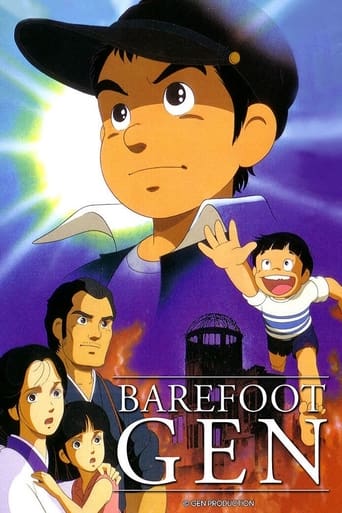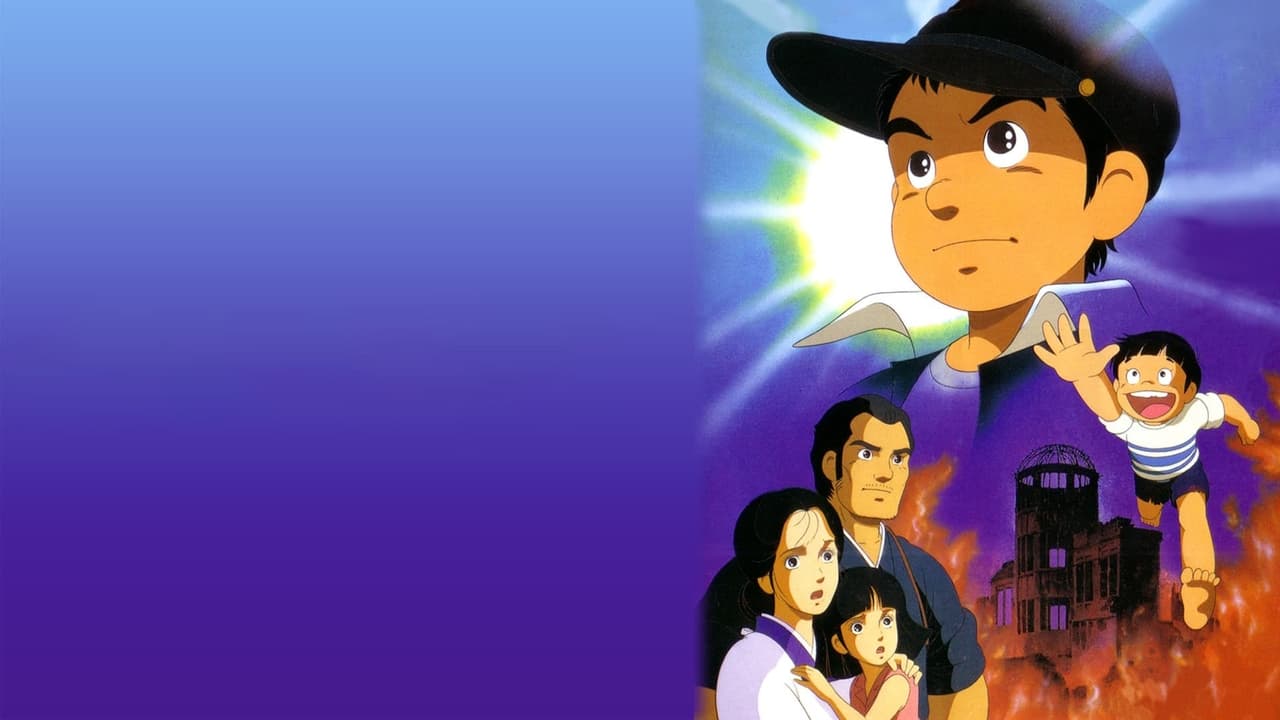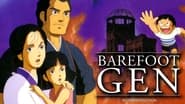sharky_55
Sometimes there are events almost too tragic to capture on film. Two nuclear bombs were dropped onto Japanese cities, and it was two too many. Barefoot Gen is almost completely removed from the background of the war, the politics surrounding the surrender, the mounting firebombing of the surrounding cities. While some might point to this as a weakness, I see it as a strength. There is no need for a film like this to entangle itself into that debate which turns human lives into statistics and percentages. It depicts the innocent civilians who were far away from this process, and who had to bear the shocking tragedy instead. Keiji Nakazawa knows the material well. He too lost his family in the bombings of Hiroshima, and first detailed his experiences in the manga series that would spawn several movie adaptations including this one. In this little animated film he has found perhaps the only suitable medium that could even begin to visualise the horrors of the nuclear bombings. There were live-action films too, but it is tremendously difficult to handle not only the calibre of special effects that would fully capture the effects of the radiation, but also to direct real actors (never mind a little boy) into reacting to such a delicate issue. Barefoot Gen initially tricks you with its animation. Nakaoka and his brother bounce around with the freedom of characters drawn on the page, which accentuates their rounded cheeks and ears, their big saucer- eyes, the way their eyebrows snake like caterpillars to help emote. When they quarrel and chase each other for the last piece of food in the house, the walls close in and warp and move with them; a classical technique that has been used many times before to make characters seem faster than they really are. It belongs in an action sequence, but what Nakazawa is really doing here is representing the struggle from the perspective of little boys. They fight and argue, making a game out of hunger, while the world crumbles around them, because that is what children their age do. They see grown men fighting over a measly bowl of soup, and register this as absurd; not because of how wretched the situation has become, but because only a nice juicy fish would be worth fighting for. But they are also inquisitive and resourceful as boys tend to be - they ponder on whether worms could be caught and eaten, and bravely offer their own bodies for physical punishment if only to feed their heavily pregnant mother.Nakaoka and Shinji collect their meagre rations for the day and wheel them home, although it is barely worth a second sniff. The gravity of the situation is never completely lose on them, but they sing songs about going off to war all the same, and march down the street as if it was simply another chore to complete (and playtime afterwards). "Banzai, banzai!" they cry. And then later Nakaoka last lost it all, but still maintains that streak of optimism and boyish cheer. They are little triumphs made tragic by the inevitability of blow-back; a secret horde of rice (that is treated like hidden treasure), successfully dragging a soldier to the medical tents (only to have him declared dead immediately), and in a pivotal moment, returning home with cartons of milk only to find it is all too late. Nakazawa plays the continual optimism and pluckiness of Nakaoka against the grim plot, and the juxtaposition is at first grating, but then takes on an increasingly morose tone. He can't help but react in the only way he knows, and we understand that a six year old boy should never have to face these circumstances. The centrepiece of the film is the sequence leading up to and including the detonation of Little Boy. How could a single plane, something so innocuous even the residents are not hurried to rush to their shelters, cause so much destruction? Nakazawa builds up the fatal moment with the heavy beat of the bass drum, but it is scarcely needed, because we all recognise and know what is about to happen. It is the dreadful ringing and silence following that is the more frightening, the way the entire city is frozen in time for a split second, and how the flash of the bomb strips the frame of colour. The animations suspends the victims in the air, and strips away their very skin and flesh. In this way the film is literally ripping apart the very essence of anime, pulling apart the cleanly drawn lines, the simple facial features, the saucer-eyes and wide-open mouths. Live-action would never dare try to touch such an atrocity. Animation makes a haunting and sad attempt.
lpgal9000
I will admit that I did not like the style of animation that was going on, but the characters were so charming that I wanted to see what happened next. I knew already that this movie was about the Hiroshima bombing, but when they showed the bombing in action, it was so tragic, I teared up and felt so sad for the women, the men, and especially the children and babies that had to endure such suffering. It is quite detailed, it shocked me as to how detailed it was considering the animation. The deaths of the father, daughter, and youngest son was also very tragic and shocking. You'd think "they're not going to die, they're going to live and somehow find a way to survive all this" - but sadly this was not the case. The mother's reaction to their deaths seemed quite realistic and disturbing, but she was able to snap out of it for her son's sake. The birth of the daughter was sweet and brought back a smile on my face, making me think "there it is, the hope we all want to see" but her death too was very sad and tragic. The movie isn't too long, but the amount of time spent with Gen makes you like him more and more throughout the film.This movie is very much recommended for those who are interested in the Hiroshima bombing and the aftermath. This is not a kids film.
tcsshelton
I've basically pasted this from wikipedia, but since the autobiographical element to this story wasn't mentioned I thought I should post it. There is an interesting article with the artist here http://www.tcj.com/256/i_nakazawa.html (中沢 啓治, Keiji Nakazawa, born 1939) is a Japanese manga artist and writer.He was born in Hiroshima, and was in the city when it was destroyed by an atomic bomb in 1945. All of his family members who had not been evacuated died in the bombing except for his mother, and an infant sister who died several weeks after the bombing.In 1961, Nakazawa moved to Tokyo to become a full-time cartoonist, and produced short pieces for manga anthologies such as Shonen Gaho, Shonen King, and Bokura.In 1966, following the death of his mother, Nakazawa returned to his memories of the destruction of Hiroshima and began to express them in his stories. Kuroi Ame ni Utarete (Struck by Black Rain), the first of a series of five books, was a fictional story of Hiroshima survivors involved in the postwar black market. In 1972, Nakazawa chose to portray his own experience directly in the story "Ore wa Mita" ("I Saw It"), published in Monthly Shonen Jump (In 1982, the story was translated into English and published as a one-shot comic book by Educomics as "I Saw It").Immediately after finishing "I Saw It", Nakazawa began his major work, Hadashi no Gen (Barefoot Gen). This series, which eventually filled ten volumes (six volumes in English translation), was based on the same events as "I Saw It" but fictionalized, with the young Gen as a stand-in for the author. Barefoot Gen depicted the bombing and its aftermath in graphic detail, but also turned a critical eye on the militarization of Japanese society in the World War II years, and on the sometimes abusive dynamics of the traditional family. Barefoot Gen was made into an animated film, released in 1983. It was followed three years later by a sequel.
geoffward2003
I just watched this film for the first time yesterday. I signed up for a free 1 month trial DVD delivery, and filled my queue with Anime. There is so much more than Robots and Vampires. Robots and Vampires have their place and in Anime they can often have deep meaningful stories.This film is definitely one I will add to my collection. The subject is very important. We usually Hiroshima from an American point of view. It is important to see it from a Japanese view. the movie actually doesn't seem to make a point to say that the US was bad. I don't think an American film would be so non-judgemental.Watch this film for it's real (and sometimes over the top) emotions.The home life of the family and the interactions between the parents and children reminded me so much of parts of my life in South Korea for the past 12 years. though differences exist between Japan and Korea, some basics are similar. Nowadays the common life shown in the film is fading. I think it will be a good reminder of how things were.Watch this and 'Barefoot Gen 2'.


 AD
AD







